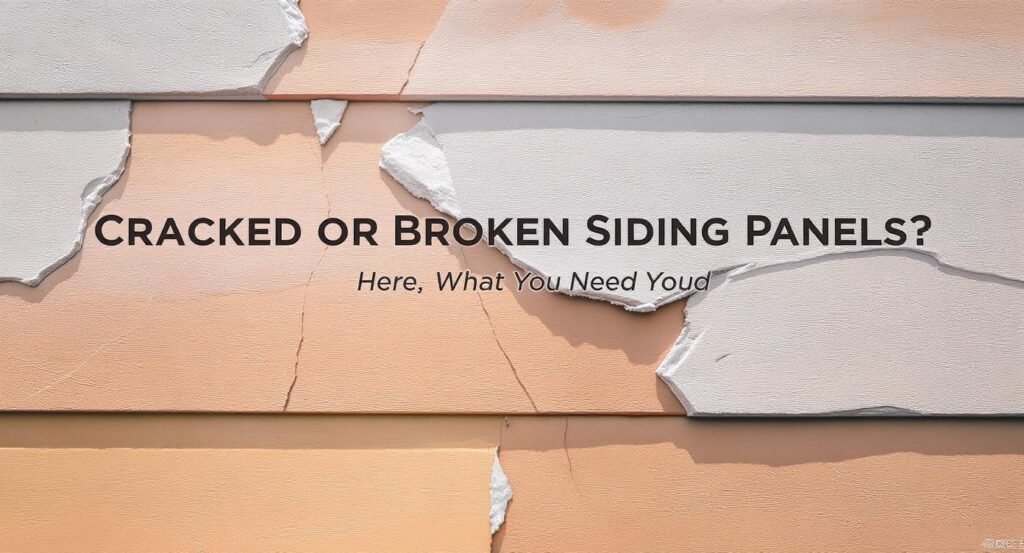
Vinyl Siding Problem Solver
Assess your siding damage and get expert recommendations
Siding Damage Assessment Tool
Answer a few questions about your vinyl siding to get personalized recommendations.
Understanding Vinyl Siding Damage
If you've noticed cracks or breaks in your vinyl siding, you're not alone. Over time, weather, impact, and even aging materials can cause siding panels to warp, split, or crack. While these issues may seem cosmetic at first, cracked or broken siding can lead to serious problems—including water damage, energy loss, and reduced curb appeal.
Immediate Risks
Water infiltration can lead to mold, mildew, and structural damage if not addressed quickly.
Long-Term Effects
Damaged siding reduces energy efficiency and can decrease your home's value by up to 10%.
What Causes Siding Panels to Crack or Break?
There are several reasons why your vinyl siding may be cracked, split, or broken:
Impact Damage
A stray baseball, hailstorm, or fallen tree branch can easily dent or break siding panels.
Weather Extremes
Ohio's climate can be tough on exterior materials with intense sun and freezing temperatures.
Poor Installation
Improper nailing or tight installation leaves no room for expansion.
Old Age
If your siding is more than 15–20 years old, it may be brittle or structurally compromised.
Why Cracked or Broken Siding is a Big Deal
Don't Ignore Siding Damage
While a small crack might not seem like an emergency, it opens the door to larger issues.
- Water Infiltration: Allows moisture to seep behind panels, leading to mold and rot
- Increased Energy Bills: Compromises insulation leading to heating/cooling inefficiency
- Pest Invasion: Rodents and insects can enter through small cracks
- Curb Appeal: Makes your home look worn down, affecting property value
How to Inspect for Siding Damage
It's a good idea to inspect your home's siding twice a year—in the spring and fall—or after severe weather.
Step-by-Step Siding Inspection:
- Walk around your home slowly, scanning each wall
- Look for visible cracks, chips, or holes
- Check for warped, bowed, or loose panels
- Look for signs of discoloration, mildew, or bubbling
- Inspect caulking and seams—cracking here can allow moisture in
- Check under the eaves and around corners—common spots for damage
Repair or Replace? What's the Best Option?
The big question: Should you repair cracked siding or replace it entirely? The answer depends on the extent of the damage, age of the siding, and your long-term goals.
When Repairs Make Sense
- Only 1–2 panels are damaged
- Siding is relatively new
- Panels are still in production (easy color match)
- Damage is minor (hairline cracks or small chips)
When Replacement is Better
- Multiple panels are cracked or faded
- Your siding is over 15 years old
- Damage has affected the underlayment
- You're considering upgrading for better insulation
DIY Repairs vs. Hiring a Professional
You might be tempted to handle minor siding damage on your own. While some handy homeowners can manage small cracks with a repair kit, it's usually best to leave siding repairs and replacements to the pros.
Why Professional Help Makes a Difference
Proper Color Matching
Structural Assessment
Warranty Coverage
Code Compliance
Preventing Future Siding Damage
While no siding lasts forever, here are a few ways to minimize the risk of cracks and breakage:
Maintenance Tips
- Clean siding annually with mild soap and water
- Trim trees and bushes away from exterior walls
- Inspect after storms and freeze-thaw cycles
- Schedule regular professional inspections
Need Professional Help With Your Siding?
At Ohio Vinyl Siding Guru, we specialize in vinyl siding repair and full replacement services in Lima, Findlay, Dayton, Toledo, and surrounding Ohio communities.
(567) 471-6816We offer:
- Fast, honest inspections
- Transparent pricing
- High-quality materials
- Guaranteed workmanship


